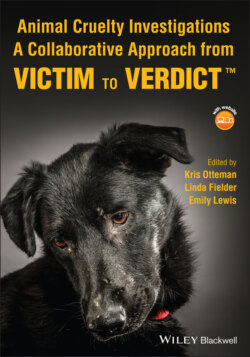Читать книгу Animal Cruelty Investigations - Группа авторов - Страница 140
3.11 Nonaccidental Injury and Trauma
ОглавлениеInvestigations of traumatic injury and physical abuse of an animal require a swift response and keen interview skills. Because evidence of abuse such as bruising, limping, and wounds can heal quickly, it is important to facilitate veterinary examination of the animal and interview witnesses and suspects as soon as possible after receiving the report. A veterinarian will be able to uncover injuries through examination, X‐ray, and other diagnostics. Their medical record and reports along with photos, videos, and test results can guide the investigator to ask questions that will shed light on the facts that led to the animal's injury or death. Likewise, information the officer gleans from interviewing witnesses and suspects can guide the veterinarian in his or her examination and diagnostic plan.
Nonaccidental injury cases can include drowning, burning, asphyxiation, beating (Figure 3.9), sexual abuse, shooting, and torture. The list is as long as the list of injurious and assault crimes humans commit toward one another. People who commit these crimes toward animals may also be abusing family members or committing other crimes in the community. Many are in need of professional mental health assessment and services. Animal abuse cases should never be set aside because the victim was “just a cat” or the owner “lost their temper,” when disciplining their puppy.
Figure 3.9 There is a well‐established link between animal abuse and other violent crimes.
Source: Oregon Humane Society.
